Creating a Family-Friendly Snack Drawer
Disclaimer: Some of the links in this post are affiliate links. While these do not cost you more to use, they do provide Veggies & Virtue with a small commission for any purchased made through the links. As always, all opinions are my own.
Right before our third child was born, I had this random idea to convert the lowest drawer in our fridge to a “snack drawer.” This way, whether it be my parents helping with my older kids over snack time (while I was newly with the baby) or needing to reach for something satisfying myself, we had a kid-friendly snack drawer stocked with nourishing options at any given time.
Since sharing about this on Instagram, I have gotten several questions about this drawer, how it is used (or could be abused!), and more on the logistics about keeping the food fresh.
That’s why in this week’s post, I created a central spot for all things snack drawer related - including your questions, my answers, and other aspects that commonly come up regarding real life applications for this drawer!
Creating a Kid-Friendly Snack Drawer
Kid-Friendly Snack Drawer 101
Our snack-drawer is intended to help make front and center some of the options I may want to offer my kids at snack time. Amidst the hustle of kids and the mental energy it often takes to come up with variety, adding different options from varying food groups (thus with differing nutritional beenfits) to this drawer has helped lessen the mental fatigue of what to offer at snack time by making it conveniently located in one place.
Some families may find this type of set up works better specifically for lunch-packing, particularly if you have older kids who pack their lunches independently (more on how to foster that from Real Mom Nutrition). We use it in combination for morning snacks (since I still have two kids at home and one whom I send a school-snack for daily), afternoon snacks, and to round out lunchboxes as well.
Some of our favorite foods for the snack-drawer (by food group):
Veggies:
Baby carrots
Mini cucumbers
Bell peppers or baby bell peppers
Broccoli or cauliflower
Zucchini muffins
Carrot muffins
Fruits:
Apples
Applesauce
Oranges or clementines
Fresh berries
Grapes
Fats and/or Proteins:
Yogurt tubes or cups
Hummus cups
Guacamole
Greek yogurt ranch dip
Cheese
Hard boiled eggs
Energy bites
Starches
Muffin Club muffins
Banana avocado Breakfast Cookies
Leftover Pancakes
Granola-Based energy bites
What kind of fridge I have
We have an LG French Door fridge in 2015, but this seems to be the closest model currently available. We needed a shallow option to fit our space and yet I have been very pleased with how much space we have in it. For those curious or in the market for a fridge, you can view models similar to ours here (not sponsored; just sharing because we love ours and are asked about it often!).
*Update: As of August 2024, we have this model of fridge.
What kinds of containers do you use
At the advice of Emily Ley, I try really hard to re-purpose storage solutions we already own before going out and buying a budget of expensive ones. Thankfully, we had some shallow bins that fit perfectly in our drawer. They are similar in shape to those you might store 8.5 x 11” documents in (as we omit the lid). These allow two main, larger compartments for options, which you could find something similar to at a Dollar Tree, Walmart, or Target. For ease of reference, I have linked something similar here or a slightly deeper option here (if it fits your space) on Amazon. I supplement the extra space remaining with some of the following products:
How to create the space in whatever fridge you have
Many of you have said this is a great idea but it doesn’t work for your given fridge! Here are a few ideas to consider:
When was the last time you cleaned out your fridge? Consider doing a deep clean, clearing everything out so that you have a blank slate. Then, use bins you have on hand or buy to fit your fridge to organize condiments and sauces, fruits, vegetables, proteins, etc. This will help you see when you have “too many” open bottles of something or an overflowing bin of another category. This helps prevent food waste while promoting optimization of whatever space you have.
Could you consolidate options? Maybe you commit to only two salad dressings can be open at a time vs six. Or unless one ketchup is empty, you don’t have another one stored. Or you keep the extra unopened peanut butter in the pantry until it has been opened. This might seem small, but each of these little changes can add up to pockets of added space.
Where is the most realistic place to put a kid-friendly snack “drawer”? Of note, this might be a cubby bin rather than a drawer at all depending on your fridge! Just allocate one area in your fridge to refill weekly with a few easy options to have on hand and readily available.
Where can you re-assign other food items to a new home? Our snack drawer was originally intended for meats and cheeses. Well, that was A LOT of space for meat and cheese. So instead what I did was I moved the meat and cheese up to occupy one of the two fruit and vegetable drawers. Did that mean I started buying less fruits and veggies? Of course not! I just reassigned where we stored them, which actually motivated me to wash and prep more options for the snack drawer or to have in bigger bowls on the top shelves to serve with family-style meals.
How is the snack drawer used (i.e. not abused)?
Many of you know that at the time of this writing, I have one, three, and five year old children. That means, NONE of them are given free reign on the fridge let alone this drawer.
Depending on the ages of your child(ren), I do have clients who I teach to set something up like this with their older children as the Division of Responsibility becomes delegated in later ages and stages.
In our home, however, I use this more for my own sake and sanity than to enable bad behavior or endless snacking in my kids. They have been born and raised with the Division of Responsibility so they are well-versed in my being in charge of what, when, and where food is offered? Does that mean they never walk up to the fridge and ask to have a snack outside of snack time? Of course not. We aren’t a militant family; just one with clearly communicated boundaries spoken in love but with firm limits.
Instead, it gives me predetermined options and variety each week from what I have set out ahead of time as some healthy options they can have. So when it comes snack time, I can open the drawer and easily take out 2-3 options. Usually, our baseline combo is “1 produce + 1 protein.” But I walk through this concept (i.e. how to make more filling snacks) in much more detail here.
That means combinations like:
Carrots + Hummus
Apples + Almond Butter
Celery + Peanut Butter
Berries + Yogurt
Bell Peppers + Guacamole
Cucumbers + Cheese
Grapes + Energy Bite
Broccoli and Cauliflower + Greek Ranch Dip
Applesauce + Muffin
Oranges + Hard Boiled Eggs
Offering such kid-friendly snack options as this ensures that snack time is used to fill in nutritional gaps (being food groups they otherwise may not have eaten as much from in a given day or week) rather than reaching for the easiest, often nutrient-poor option in the pantry.
We do supplement with food from the pantry at times, also. This is a decision I make, however, based on how filling I want their snacks to be. If I know they have soccer practice so we are eating an early dinner, I will likely scale back the volume, protein, or fat in a given snack so they have an appetite for an early dinner. Then, upon getting home, when we offer a bedtime snack on sports nights, I bulk up what they get out of here to offer more filling power from such protein or fat.
Other Commonly Asked Questions:
How do you keep your kids from binging on snacks? My 4 & 6 year old would only eat snacks and never meals if I gave them access to them.
If you are new to a Division of Responsibility, something like a snack drawer may create more confusion than assistance initially. That’s because your children need to know you get to decide what, when, and where their snacks are being offered. If kids think that they can graze endlessly when given access to options (be it in a kid-friendly snack drawer or anywhere), that will create some challenges in the feeding relationship and likely hinder their appetite come meal times. To prevent this, establish a “Kitchen is Closed” policy when it isn’t time to eat (a meal or snack). Reinforce it when they try to eat outside of such times. Then, as boundaries are understood, see if creating a snack drawer like this cuts out some of the confusion on what’s for snack (or not) - both for you and for them. Having it in a preset place doesn’t change the behaviors expected around snacking and what, when, and where it is offered. It simply creates a space for you to store new options and offer different snack combinations from.
When are they allowed snacks? Do you find they wont eat meals and go to this instead?
My kids are allowed snacks from this drawer at snack time. We continue to have a policy that we eat at meals and snacks and not outside of those times. They do not have the option to eat from this drawer in place of meals, again partly because that has never been an option in our home. They know they get to choose if/whether and how much to eat from what is offered at a given meal, but other options (like those “safe” ones in this drawer) are not offered in place of their choosing not to eat.
What age did you start at?
This was not necessarily due to developmental age as our age of survival, but I first created this snack drawer when my oldest was 4.5 and middle was 2.5, due to their baby brother being born. It was an easy way for me to have snacks ready for my parents, husband, a babysitter, etc. if/when I was busy with the newborn and needed to delegate snack duty to someone else.
As long as a Division of Responsibility is in place in your family, this drawer could be used successfully. As mentioned above, this is something that you can begin to include older kids in filling or pulling from in early adolescents, as they begin to manage more of their own feeding.
How long does the food in this drawer last?
Depending on the week, what other snacks we might have or make along the way, my kids appetites, etc., I usually fill this on the weekend and it lasts us to/through the following Friday. Then, I refill again for the next week. I usually promote we eat the foods that will spoil most quickly in the first few days (like cut veggies or berries) and save the less perishable options for the latter half of the week (like apples, carrots, and packaged options).
Any tips for keeping items fresh (like berries/uncovered energy balls etc.)?
For taking pictures, I remove all lids. To store, however, I cover everything except for some fruit. I find that berries and grapes do best when washed and stores with a paper towel in the bottom of the container left UNcovered. Other than that, I stored cut fruits like melons, vegetables, or energy bites with reusable bags or Pyrex snapwear lids. For vegetables, I often wait to cut them until snack time itself (particularly those more perishable like bell peppers or cucumbers) to prevent spoilage.
Do I replenish as the week goes on?
If it runs out and I remember to, yes. Otherwise we just eat from it until it is empty and they we may have 1-2 days before I get to restocking it. Or, I might add just a few things to help carry us from whenever it runs out to when I “officially” refill it.
Want to see more examples of past Kid-Friendly Snack Drawers?
Scroll through those shared here:
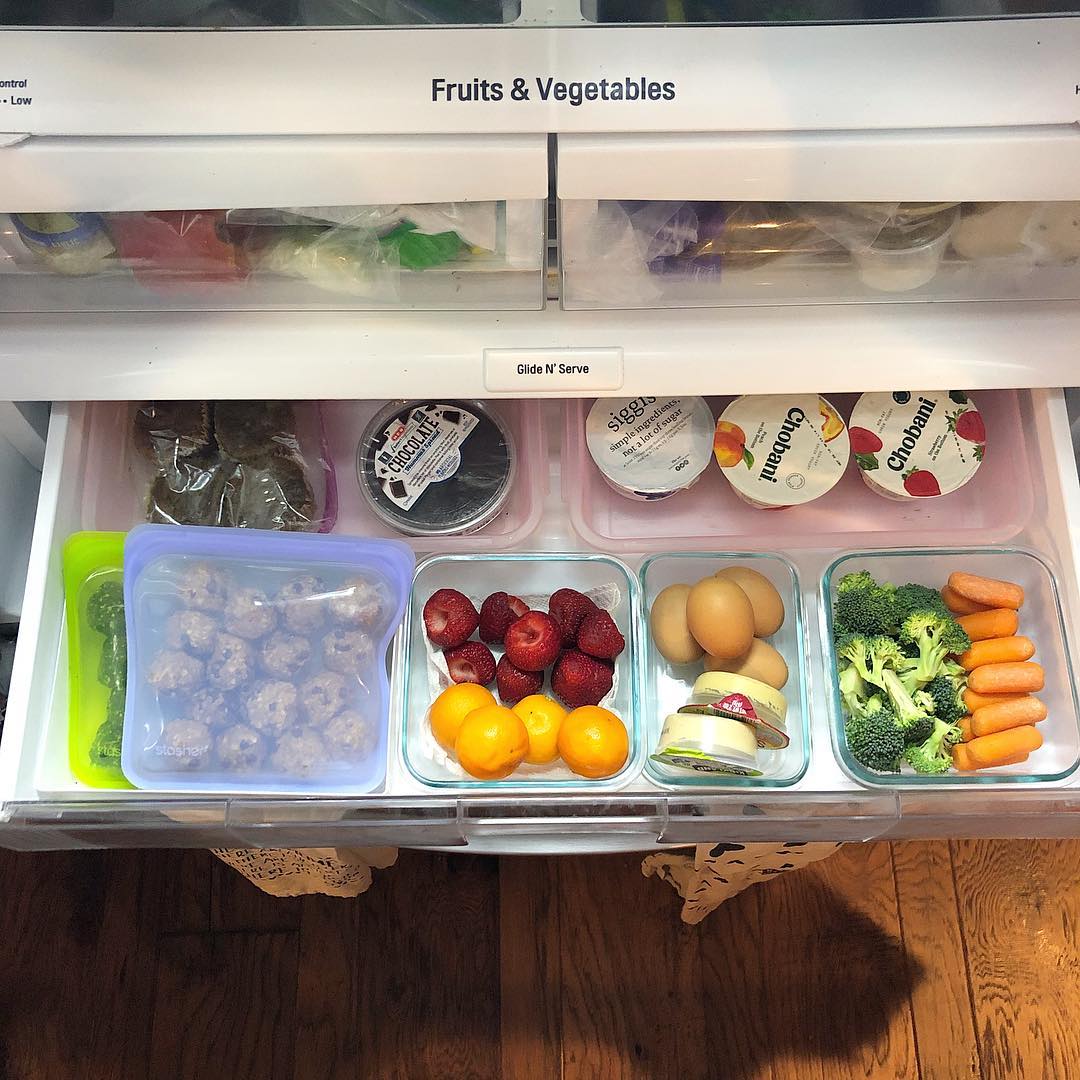
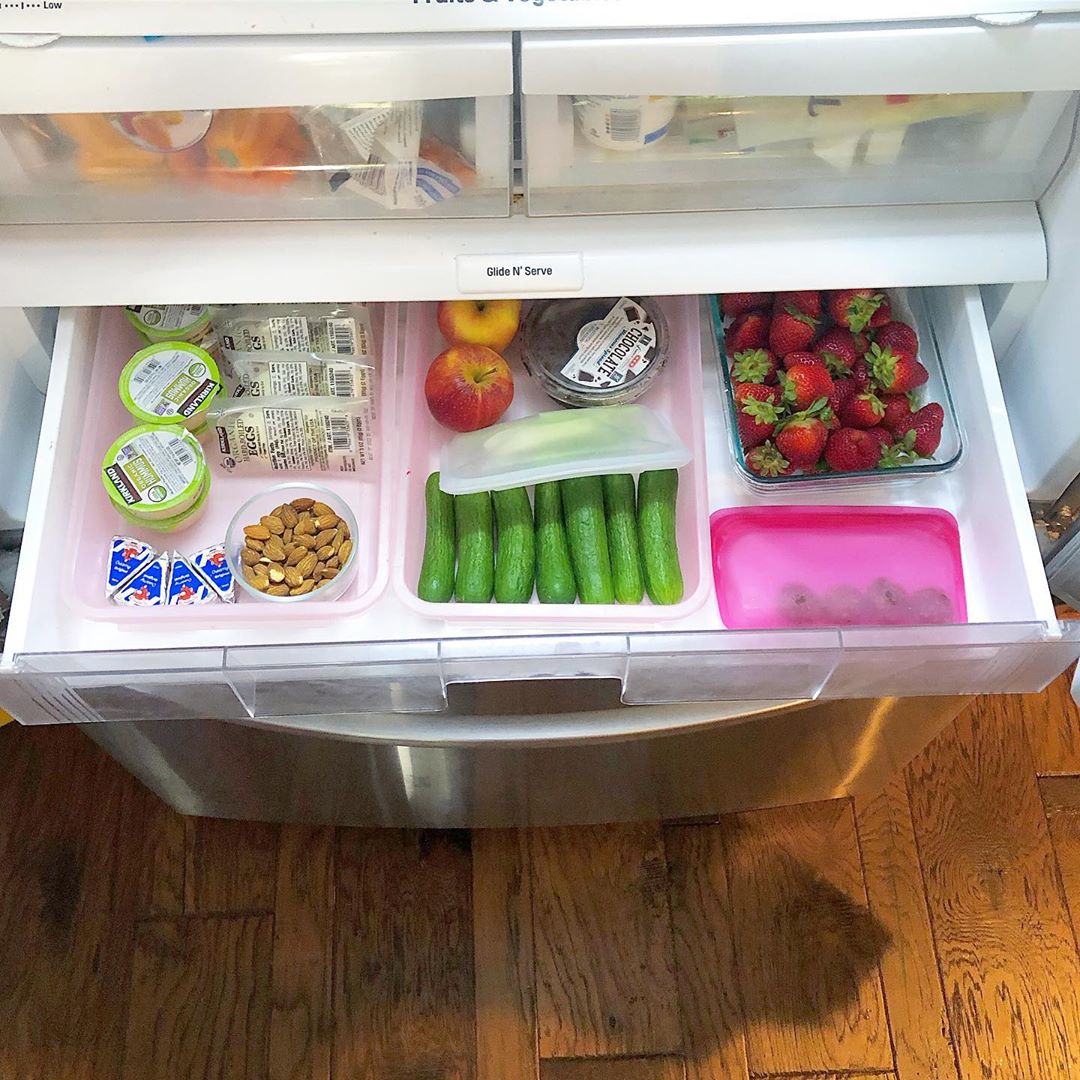
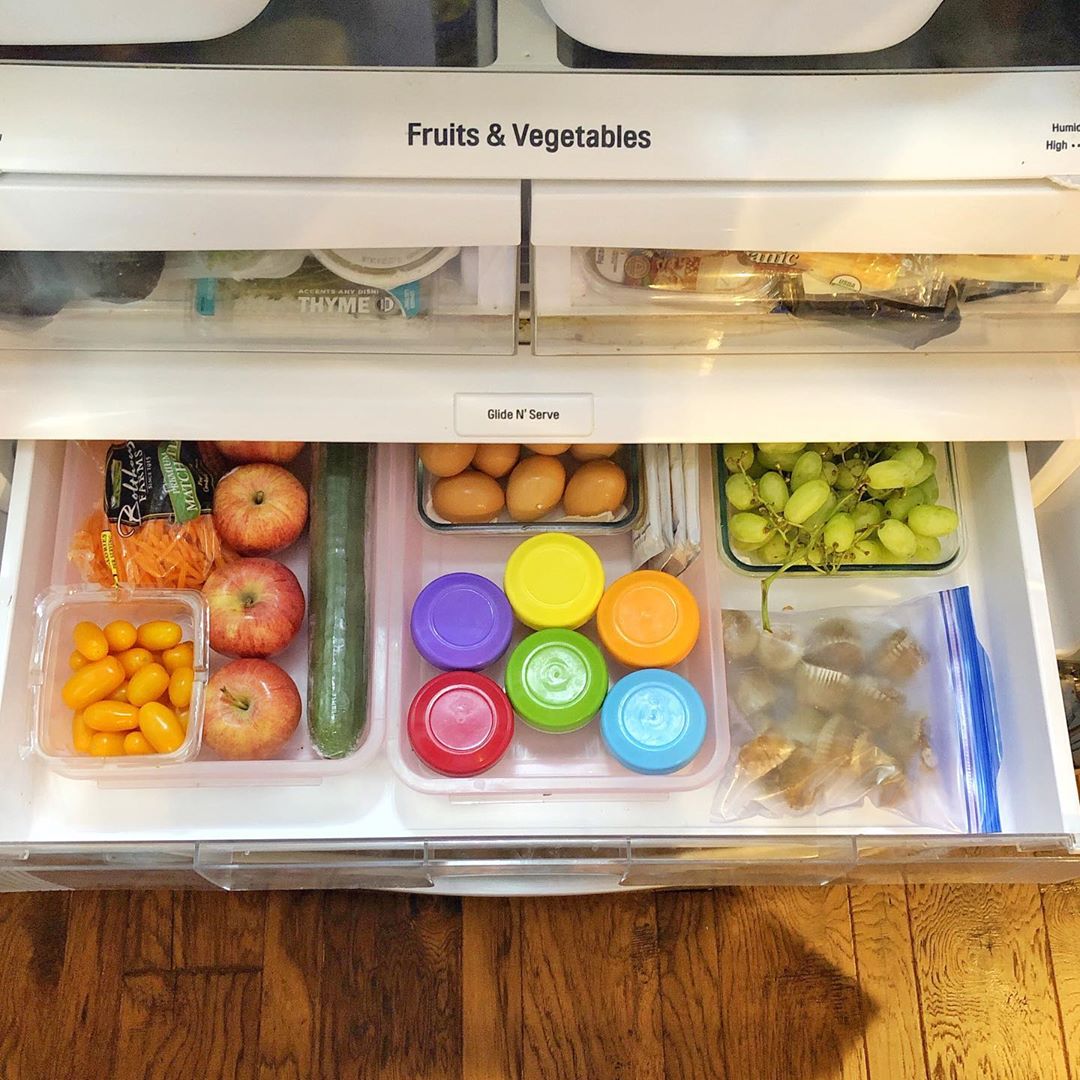
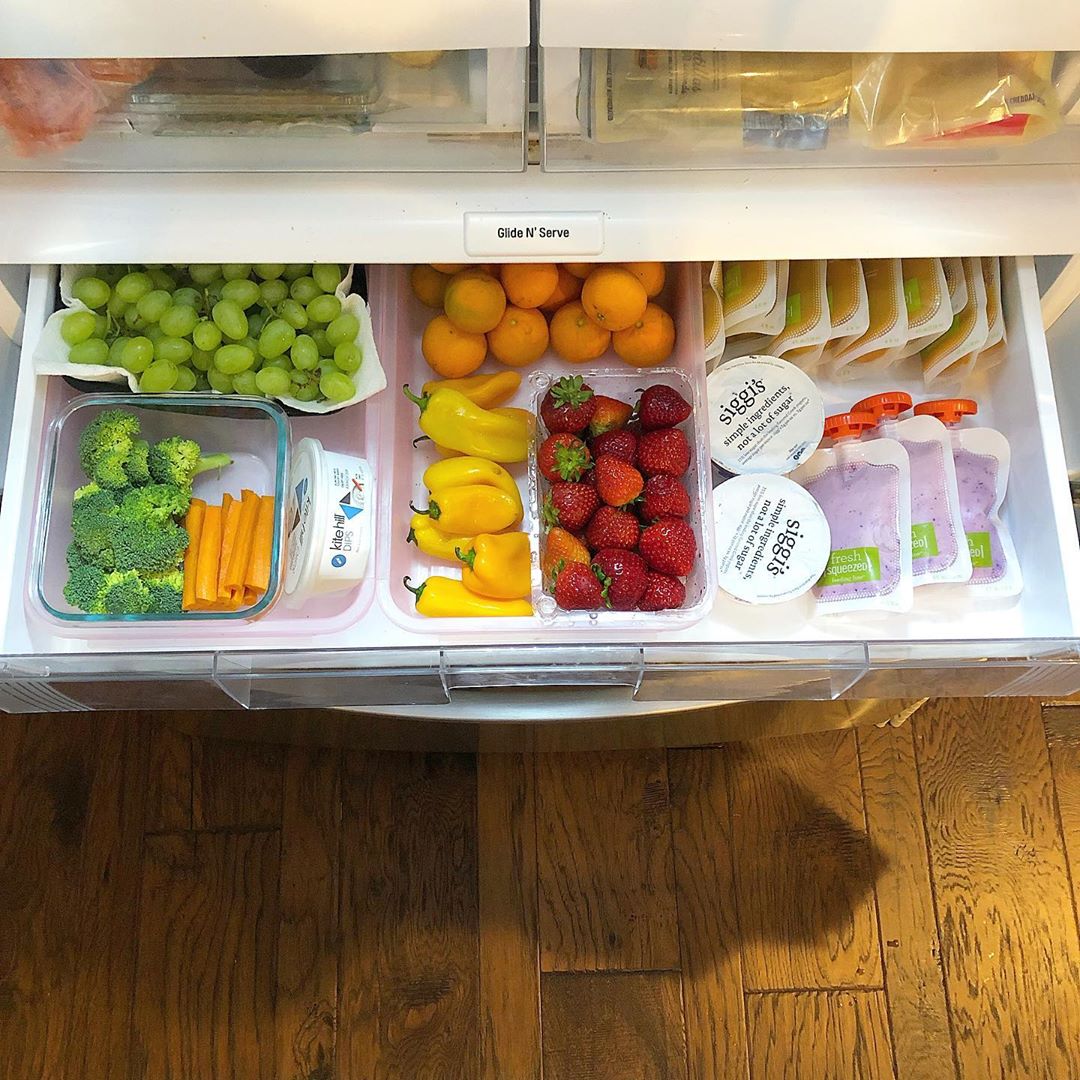
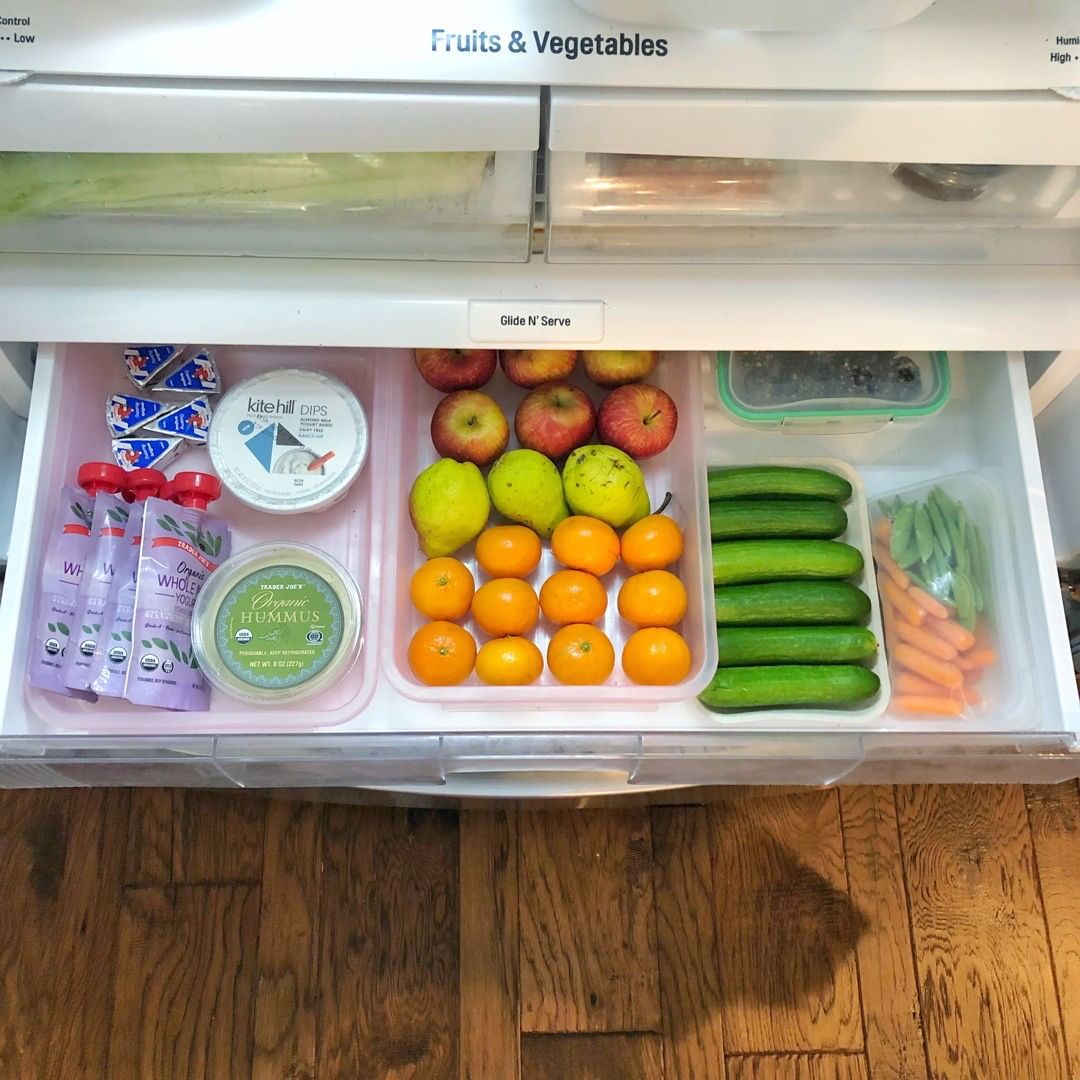

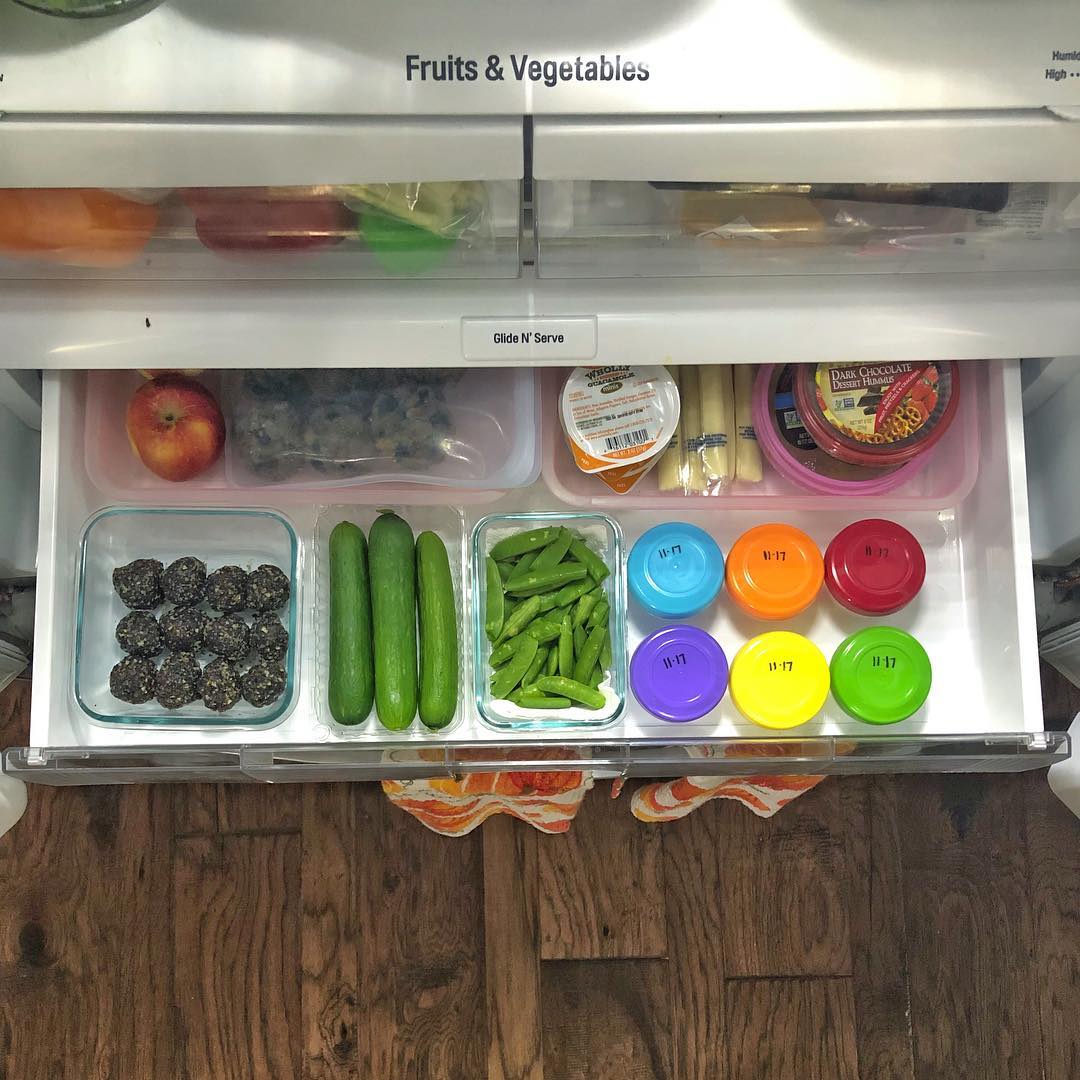
Now, it is YOUR turn!
Grab my freebie with 75+ of my favorite snacks for fueling kids here.



